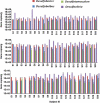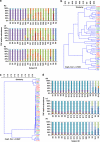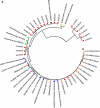Abundance and diversity of mucosa-associated hydrogenotrophic microbes in the healthy human colon
- PMID: 21753800
- PMCID: PMC3246246
- DOI: 10.1038/ismej.2011.90
Abundance and diversity of mucosa-associated hydrogenotrophic microbes in the healthy human colon
Abstract
Hydrogenotrophic microbiota have a significant impact on colonic health; however, little is known about their diversity and ecology in situ. Here, molecular-based methods and multivariate analyses were used to examine the abundance and diversity of mucosa-associated hydrogenotrophic microbes in 90 biopsies collected from right colon, left colon and rectum of 25 healthy subjects. Functional genes of all three hydrogenotrophic groups were detected in at least one colonic region of all subjects. Methanogenic archaea (MA) constituted approximately one half of the hydrogenotrophic microbiota in each colonic region. Sulfate-reducing bacteria (SRB) were more abundant than acetogens in right colon, while acetogens were more abundant than SRB in left colon and rectum. MA genotypes exhibited low diversity, whereas SRB genotypes were diverse and generally similar across the three regions within subject but significantly variable among subjects. Multivariate cluster analysis defined subject-specific patterns for the diversity of SRB genotypes; however, neither subject- nor region-specific clusters were observed for the abundance of hydrogenotrophic functional genes. Sequence analyses of functional gene clones revealed that mucosa-associated SRB were phylogenetically related to Desulfovibrio piger, Desulfovibrio desulfuricans and Bilophila wadsworthia; whereas MA were related to Methanobrevibacter spp., Mb. smithii and the order Methanomicrobiales. Together these data demonstrate for the first time that the human colonic mucosa is persistently colonized by all three groups of hydrogenotrophic microbes, which exhibit segmental and interindividual variation in abundance and diversity.
Figures







Similar articles
-
On the relationship between sialomucin and sulfomucin expression and hydrogenotrophic microbes in the human colonic mucosa.PLoS One. 2011;6(9):e24447. doi: 10.1371/journal.pone.0024447. Epub 2011 Sep 9. PLoS One. 2011. PMID: 21931721 Free PMC article.
-
Numerical ecology validates a biogeographical distribution and gender-based effect on mucosa-associated bacteria along the human colon.ISME J. 2011 May;5(5):801-9. doi: 10.1038/ismej.2010.177. Epub 2010 Dec 2. ISME J. 2011. PMID: 21124491 Free PMC article.
-
Molecular ecological analysis of the succession and diversity of sulfate-reducing bacteria in the mouse gastrointestinal tract.Appl Environ Microbiol. 2000 May;66(5):2166-74. doi: 10.1128/AEM.66.5.2166-2174.2000. Appl Environ Microbiol. 2000. PMID: 10788396 Free PMC article.
-
Archaea as emerging organisms in complex human microbiomes.Anaerobe. 2011 Apr;17(2):56-63. doi: 10.1016/j.anaerobe.2011.03.001. Epub 2011 Mar 21. Anaerobe. 2011. PMID: 21420503 Review.
-
Laboratory tools for detection of archaea in humans.Clin Microbiol Infect. 2012 Sep;18(9):825-33. doi: 10.1111/j.1469-0691.2012.03952.x. Clin Microbiol Infect. 2012. PMID: 22897827 Review.
Cited by
-
Xylan Prebiotics and the Gut Microbiome Promote Health and Wellbeing: Potential Novel Roles for Pentosan Polysulfate.Pharmaceuticals (Basel). 2022 Sep 16;15(9):1151. doi: 10.3390/ph15091151. Pharmaceuticals (Basel). 2022. PMID: 36145372 Free PMC article. Review.
-
The role of the gut microbiota in nutrition and health.Nat Rev Gastroenterol Hepatol. 2012 Sep 4;9(10):577-89. doi: 10.1038/nrgastro.2012.156. eCollection 2012 Oct. Nat Rev Gastroenterol Hepatol. 2012. PMID: 22945443 Review.
-
On the relationship between sialomucin and sulfomucin expression and hydrogenotrophic microbes in the human colonic mucosa.PLoS One. 2011;6(9):e24447. doi: 10.1371/journal.pone.0024447. Epub 2011 Sep 9. PLoS One. 2011. PMID: 21931721 Free PMC article.
-
Bioengineered Systems and Designer Matrices That Recapitulate the Intestinal Stem Cell Niche.Cell Mol Gastroenterol Hepatol. 2018 Jan 17;5(3):440-453.e1. doi: 10.1016/j.jcmgh.2018.01.008. eCollection 2018 Mar. Cell Mol Gastroenterol Hepatol. 2018. PMID: 29675459 Free PMC article. Review.
-
"Driver-passenger" bacteria and their metabolites in the pathogenesis of colorectal cancer.Gut Microbes. 2021 Jan-Dec;13(1):1941710. doi: 10.1080/19490976.2021.1941710. Gut Microbes. 2021. PMID: 34225577 Free PMC article. Review.
References
-
- Anderson MJ, Crist TO, Chase JM, Vellend M, Inouye BD, Freestone AL, et al. Navigating the multiple meanings of beta diversity: a roadmap for the practicing ecologist. Ecol Lett. 2011;14:19–28. - PubMed
-
- Attene-Ramos MS, Wagner ED, Plewa MJ, Gaskins HR. Evidence that hydrogen sulfide is a genotoxic agent. Mol Cancer Res. 2006;4:9–14. - PubMed
-
- Bakke I, De Schryver P, Boon N, Vadstein O. PCR-based community structure studies of bacteria associated with eukaryotic organisms: a simple PCR strategy to avoid co-amplification of eukaryotic DNA. J Microbiol Methods. 2011;84:349–351. - PubMed
-
- Barneah O, Ben-Dov E, Kramarsky-Winter E, Kushmaro A. Characterization of black band disease in Red Sea stony corals. Environ Microbiol. 2007;9:1995–2006. - PubMed
Publication types
MeSH terms
LinkOut - more resources
Full Text Sources
Miscellaneous

